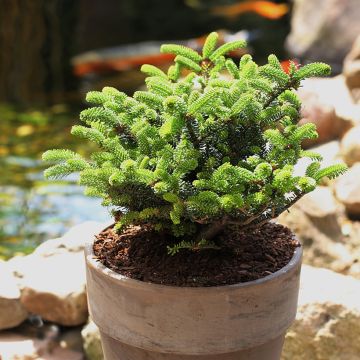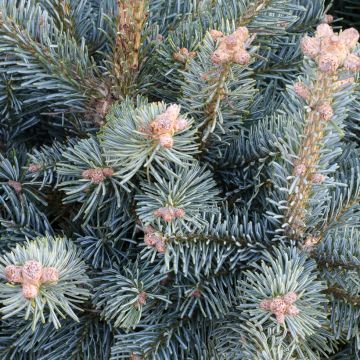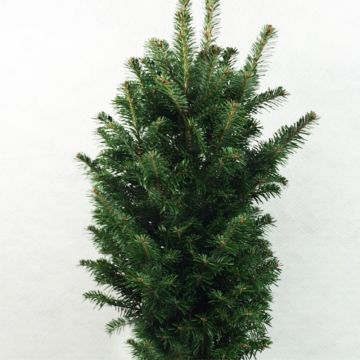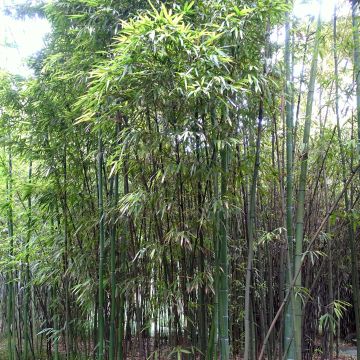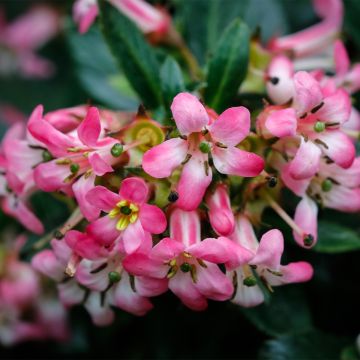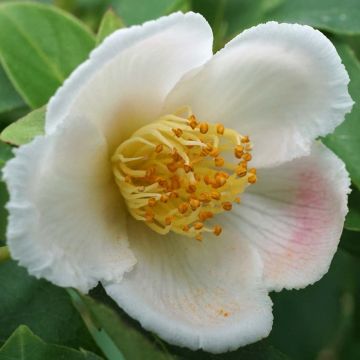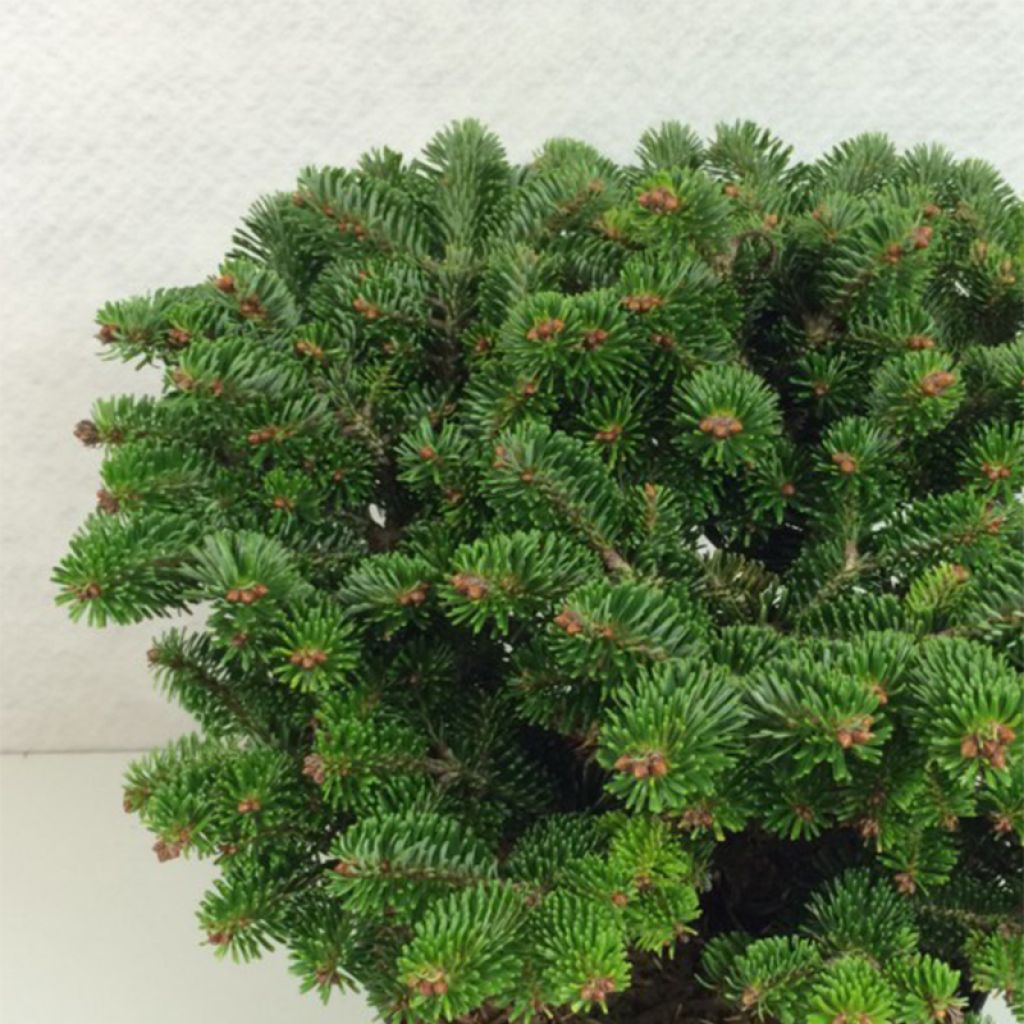

Abies nordmanniana Münsterland - Sapin de Nordmann nain
Abies nordmanniana subsp. nordmanniana Münsterland - Fir
Abies nordmanniana Münsterland
Nordmann Fir, Caucasian Fir
Why not try an alternative variety in stock?
View all →This plant carries a 24 months recovery warranty
More information
We guarantee the quality of our plants for a full growing cycle, and will replace at our expense any plant that fails to recover under normal climatic and planting conditions.
From €5.90 for pickup delivery and €6.90 for home delivery
Express home delivery from €8.90.
Does this plant fit my garden?
Set up your Plantfit profile →
Description
Abies nordmanniana 'Münsterland' is a miniature variety of the famous Nordmann fir that is a popular Christmas tree. This dwarf conifer resembles a cushion of layered branches, with a prostrate habit, covered in dense foliage with numerous small light green needles. It appears flattened on the ground, in a mound of small bluish-green spires. Hardy and slow-growing, it prefers moderately moist soils that are not too chalky and partial shade. It is perfect for a rock garden, a rocky slope, or as a decoration for a small garden or a beautiful pot.
Abies nordmanniana, sometimes called the Caucasian fir or the Crimean fir, is a conifer of the pine family that is native to temperate regions of Western Asia: Georgia, Russia, Armenia, as far south as the Black Sea in Turkey and Crimea. It grows in mountain forests in a rather humid continental climate, though it can tolerate temporary drought. In the wild, this species can reach heights of up to 60 metres (197 feet) and forms a trunk that can measure up to 2 metres (7 feet) in diameter.
'Münsterland' is a dwarf and prostrate form that does not exceed 30 cm (12in) in height and 50 cm (20in) in spread, after 10 years of cultivation. This small tree has a short straight trunk and very low spreading branches. Its growth is very slow. Its flat needle-shaped leaves are light green and shiny, marked by two light bands on the underside. The branches have a rounded shape, due to the radiating and very dense arrangement of the needles. Its grey-brown bark is smooth, although it can become wrinkled on mature specimens.
Abies nordmanniana 'Münsterland' is ideal for planting on a slope or for decorating small gardens, thanks to its slow growth and small size. With its miniature Christmas tree silhouette, it will be a wonderful addition to rock gardens, especially when planted in groups of 3. The architectural qualities of dwarf conifers naturally stand out in the design of a contemporary garden, which prefers the aesthetics of shapes, silhouettes, and textures over floral displays. These plants with strong personalities provide lasting structure to a border, mark pathways, and border terraces, easily replacing the strong presence of trimmed boxwood. They serve as a backdrop for small roses, peonies, or tousled grasses with complementary forms. They can also be paired with ground cover plants such as aubrietas or ceraistes, and flowering shrubs. The key is to play with volumes and colours.
Report an error about the product description
Abies nordmanniana subsp. nordmanniana Münsterland - Fir in pictures
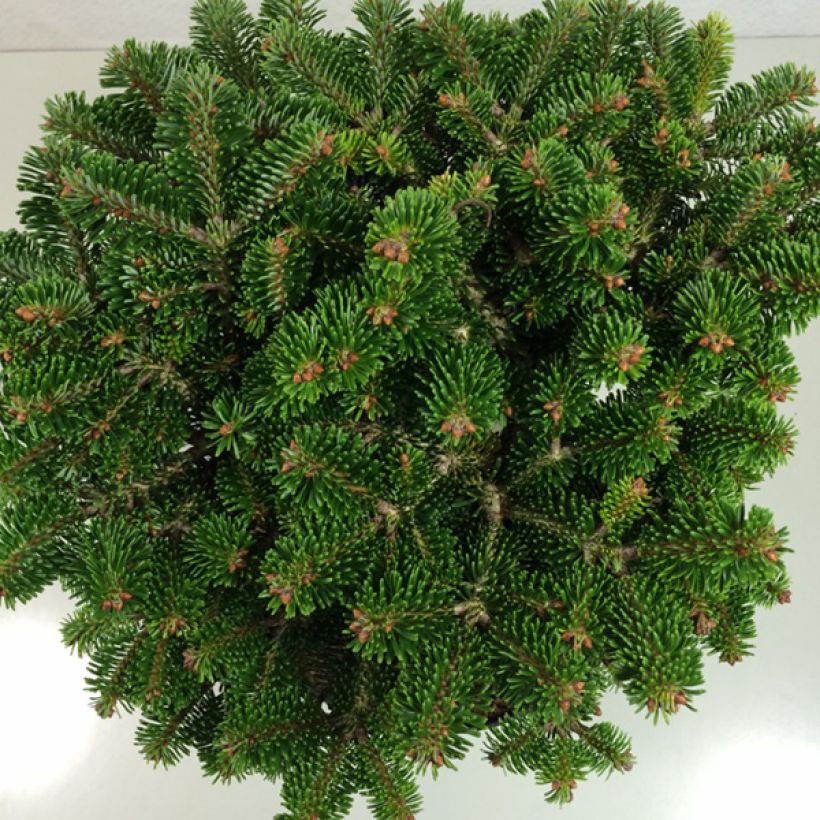



Plant habit
Foliage
Botanical data
Abies
nordmanniana
Münsterland
Pinaceae
Nordmann Fir, Caucasian Fir
Cultivar or hybrid
Other Abies
Planting and care
The 'Münsterland' Nordmann Fir is best planted in spring or autumn, in soil that retains some moisture, rich in humus, slightly acidic, neutral or slightly alkaline. This small conifer thrives in non-scorching sun or partial shade. Regularly water the young plants during the months following planting and weed the soil in summer. The dwarf Nordmann Fir tolerates occasional periods of drought, it is a fairly adaptable and very hardy species. This bush does not require pruning, but one can remove unsightly or obstructive branches to accentuate its prostrate shape.
Planting period
Intended location
Care
This item has not been reviewed yet - be the first to leave a review about it.
Evergreen shrubs
Haven't found what you were looking for?
Hardiness is the lowest winter temperature a plant can endure without suffering serious damage or even dying. However, hardiness is affected by location (a sheltered area, such as a patio), protection (winter cover) and soil type (hardiness is improved by well-drained soil).

Photo Sharing Terms & Conditions
In order to encourage gardeners to interact and share their experiences, Promesse de fleurs offers various media enabling content to be uploaded onto its Site - in particular via the ‘Photo sharing’ module.
The User agrees to refrain from:
- Posting any content that is illegal, prejudicial, insulting, racist, inciteful to hatred, revisionist, contrary to public decency, that infringes on privacy or on the privacy rights of third parties, in particular the publicity rights of persons and goods, intellectual property rights, or the right to privacy.
- Submitting content on behalf of a third party;
- Impersonate the identity of a third party and/or publish any personal information about a third party;
In general, the User undertakes to refrain from any unethical behaviour.
All Content (in particular text, comments, files, images, photos, videos, creative works, etc.), which may be subject to property or intellectual property rights, image or other private rights, shall remain the property of the User, subject to the limited rights granted by the terms of the licence granted by Promesse de fleurs as stated below. Users are at liberty to publish or not to publish such Content on the Site, notably via the ‘Photo Sharing’ facility, and accept that this Content shall be made public and freely accessible, notably on the Internet.
Users further acknowledge, undertake to have ,and guarantee that they hold all necessary rights and permissions to publish such material on the Site, in particular with regard to the legislation in force pertaining to any privacy, property, intellectual property, image, or contractual rights, or rights of any other nature. By publishing such Content on the Site, Users acknowledge accepting full liability as publishers of the Content within the meaning of the law, and grant Promesse de fleurs, free of charge, an inclusive, worldwide licence for the said Content for the entire duration of its publication, including all reproduction, representation, up/downloading, displaying, performing, transmission, and storage rights.
Users also grant permission for their name to be linked to the Content and accept that this link may not always be made available.
By engaging in posting material, Users consent to their Content becoming automatically accessible on the Internet, in particular on other sites and/or blogs and/or web pages of the Promesse de fleurs site, including in particular social pages and the Promesse de fleurs catalogue.
Users may secure the removal of entrusted content free of charge by issuing a simple request via our contact form.
The flowering period indicated on our website applies to countries and regions located in USDA zone 8 (France, the United Kingdom, Ireland, the Netherlands, etc.)
It will vary according to where you live:
- In zones 9 to 10 (Italy, Spain, Greece, etc.), flowering will occur about 2 to 4 weeks earlier.
- In zones 6 to 7 (Germany, Poland, Slovenia, and lower mountainous regions), flowering will be delayed by 2 to 3 weeks.
- In zone 5 (Central Europe, Scandinavia), blooming will be delayed by 3 to 5 weeks.
In temperate climates, pruning of spring-flowering shrubs (forsythia, spireas, etc.) should be done just after flowering.
Pruning of summer-flowering shrubs (Indian Lilac, Perovskia, etc.) can be done in winter or spring.
In cold regions as well as with frost-sensitive plants, avoid pruning too early when severe frosts may still occur.
The planting period indicated on our website applies to countries and regions located in USDA zone 8 (France, United Kingdom, Ireland, Netherlands).
It will vary according to where you live:
- In Mediterranean zones (Marseille, Madrid, Milan, etc.), autumn and winter are the best planting periods.
- In continental zones (Strasbourg, Munich, Vienna, etc.), delay planting by 2 to 3 weeks in spring and bring it forward by 2 to 4 weeks in autumn.
- In mountainous regions (the Alps, Pyrenees, Carpathians, etc.), it is best to plant in late spring (May-June) or late summer (August-September).
The harvesting period indicated on our website applies to countries and regions in USDA zone 8 (France, England, Ireland, the Netherlands).
In colder areas (Scandinavia, Poland, Austria...) fruit and vegetable harvests are likely to be delayed by 3-4 weeks.
In warmer areas (Italy, Spain, Greece, etc.), harvesting will probably take place earlier, depending on weather conditions.
The sowing periods indicated on our website apply to countries and regions within USDA Zone 8 (France, UK, Ireland, Netherlands).
In colder areas (Scandinavia, Poland, Austria...), delay any outdoor sowing by 3-4 weeks, or sow under glass.
In warmer climes (Italy, Spain, Greece, etc.), bring outdoor sowing forward by a few weeks.





































